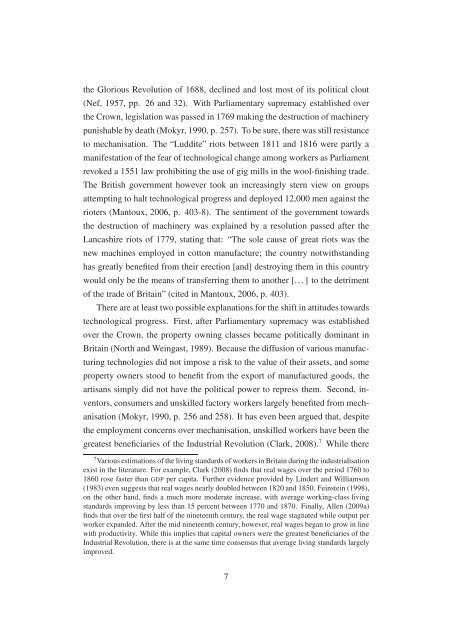The_Future_of_Employment
You also want an ePaper? Increase the reach of your titles
YUMPU automatically turns print PDFs into web optimized ePapers that Google loves.
the Glorious Revolution <strong>of</strong> 1688, declined and lost most <strong>of</strong> its political clout<br />
(Nef, 1957, pp. 26 and 32). With Parliamentary supremacy established over<br />
the Crown, legislation was passed in 1769 making the destruction <strong>of</strong> machinery<br />
punishable by death (Mokyr, 1990, p. 257). To be sure, there was still resistance<br />
to mechanisation. <strong>The</strong> “Luddite” riots between 1811 and 1816 were partly a<br />
manifestation <strong>of</strong> the fear <strong>of</strong> technological change among workers as Parliament<br />
revoked a 1551 law prohibiting the use <strong>of</strong> gig mills in the wool-finishing trade.<br />
<strong>The</strong> British government however took an increasingly stern view on groups<br />
attempting to halt technological progress and deployed 12,000 men against the<br />
rioters (Mantoux, 2006, p. 403-8). <strong>The</strong> sentiment <strong>of</strong> the government towards<br />
the destruction <strong>of</strong> machinery was explained by a resolution passed after the<br />
Lancashire riots <strong>of</strong> 1779, stating that: “<strong>The</strong> sole cause <strong>of</strong> great riots was the<br />
new machines employed in cotton manufacture; the country notwithstanding<br />
has greatly benefited from their erection [and] destroying them in this country<br />
would only be the means <strong>of</strong> transferring them to another [. . . ] to the detriment<br />
<strong>of</strong> the trade <strong>of</strong> Britain” (cited in Mantoux, 2006, p. 403).<br />
<strong>The</strong>re are at least two possible explanations for the shift in attitudes towards<br />
technological progress. First, after Parliamentary supremacy was established<br />
over the Crown, the property owning classes became politically dominant in<br />
Britain (North and Weingast, 1989). Because the diffusion <strong>of</strong> various manufacturing<br />
technologies did not impose a risk to the value <strong>of</strong> their assets, and some<br />
property owners stood to benefit from the export <strong>of</strong> manufactured goods, the<br />
artisans simply did not have the political power to repress them. Second, inventors,<br />
consumers and unskilled factory workers largely benefited from mechanisation<br />
(Mokyr, 1990, p. 256 and 258). It has even been argued that, despite<br />
the employment concerns over mechanisation, unskilled workers have been the<br />
greatest beneficiaries <strong>of</strong> the Industrial Revolution (Clark, 2008). 7 While there<br />
7 Various estimations <strong>of</strong> the living standards <strong>of</strong> workers in Britain during the industrialisation<br />
exist in the literature. For example, Clark (2008) finds that real wages over the period 1760 to<br />
1860 rose faster than GDP per capita. Further evidence provided by Lindert and Williamson<br />
(1983) even suggests that real wages nearly doubled between 1820 and 1850. Feinstein (1998),<br />
on the other hand, finds a much more moderate increase, with average working-class living<br />
standards improving by less than 15 percent between 1770 and 1870. Finally, Allen (2009a)<br />
finds that over the first half <strong>of</strong> the nineteenth century, the real wage stagnated while output per<br />
worker expanded. After the mid nineteenth century, however, real wages began to grow in line<br />
with productivity. While this implies that capital owners were the greatest beneficiaries <strong>of</strong> the<br />
Industrial Revolution, there is at the same time consensus that average living standards largely<br />
improved.<br />
7





